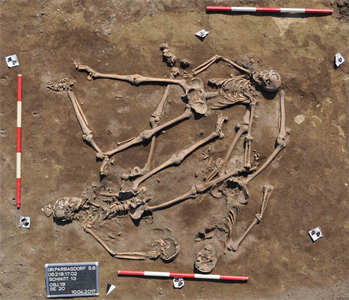In accordance with Austrian law, archaeologists have been working on a number of sites between the Austrian towns of Deutsch-Wagram and Parbasdorf, North-East of Vienna, to explore and identify any features of archaeological interest before planned construction of the new Marchfeldsnellstraβe highway begins in early 2019. Amongst the many sites being investigated by archaeologists is an area of approximately 30 hectares where the Battle of Wagram was fought on 5-6 July 1809. The Battle of Wagram was the final conflict in the bloody War of the Fifth Coalition, and took place shortly after Napoleon I’s first land defeat at the Battle of Aspern-Essling in May 1809. Involving over 300,000 soldiers, the battle lasted for two days with estimated losses of 40,000 Austrian and 34,000 French soldiers. The archaeological investigation, which began in March 2017 and is expected to continue until the end of this year, has so far yielded more than 8000 individual finds, including 2000 musket balls, 400 cannon balls and more than 500 coins dating from 1500 up to 1990. Other interesting discoveries have included vials of medicine, an elegant pocket knife with a decorated handle and more than 1000 buttons from soldiers’ tunics. Archaeologists have been able to map out with an increased level of accuracy areas of the battle based on their findings. For example, areas with lots of ammunition suggest pockets of more intense fighting, whilst objects such as horseshoes and wagon parts suggest storage routes.
On a more sombre note, the dig has also revealed a number of mass graves, each with at least six skeletons. The discovery of these skeletons has allowed a fascinating insight into conditions in the army, and reveals that diseases of malnutrition such as scurvy were commonplace, as well as respiratory diseases such as pneumonia, and inflammation of the joints from long campaign marches. Comparisons with skeletons found at the site of Aspern-Essling suggest that the six weeks between the two battles were difficult ones for the soldiers, with evidence of respiratory illness in particular rising drastically in the skeletons found at Wagram. It has also been possible in some instances to identify, from the buttons on his uniform, which regiment a soldier belonged to. So far skeletons have been found from the 1st, 2nd, 29th and 52nd regiments of the Armée d’Italie and the 9th, 23rd, 94th, 96th regiments of the Second Corps Oudinot.
Novetus, the Viennese firm in charge of the €3 million project has confirmed that there are plans to display the findings of this archaeological dig in the future.
Sources:
https://www.livescience.com/62774-mass-grave-napoleonic-wars.html
www.ancient-origins.net/news-history-archaeology/napoleonic-discovery-mass-graves-austria-0010195
http://www.deutsch-wagram.gv.at/Archaeologische_Grabungen_fuer_den_S8-Bau_2
https://www.derstandard.de/story/2000076969702/archaeologie-vor-dem-strassenbau-die-grabung-am-schlachtfeld-deutsch-wagram (including several interesting photos)
http://www.wagram1809.at/gallerie.php
http://www.wagram1809.at/eng.htm
See also our Close-up on the battle of Wagram.


